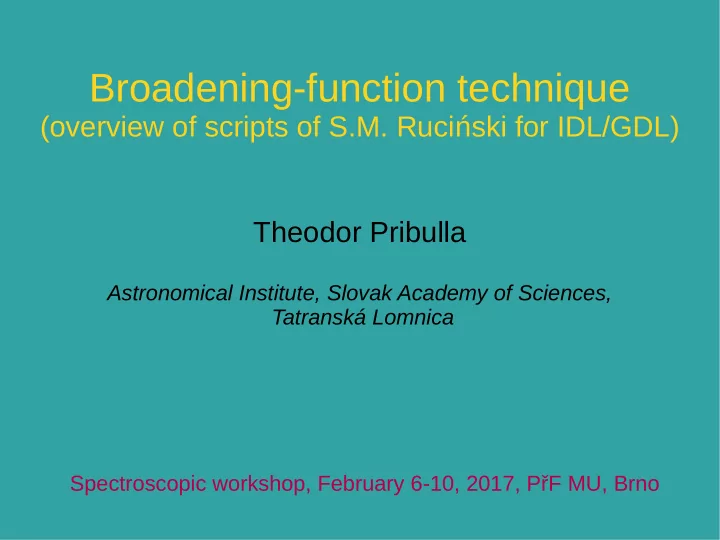

Broadening-function technique (overview of scripts of S.M. Ruciński for IDL/GDL) Theodor Pribulla Astronomical Institute, Slovak Academy of Sciences, Tatranská Lomnica Spectroscopic workshop, February 6-10, 2017, PřF MU, Brno
Astrolibrary in IDL/GDL ● Important prerequisite is the Astro library for IDL: https://idlastro.gsfc.nasa.gov/ ● It contains routines e.g. for reading/writing FITS files, performing aperture photometry (DAOphot package), barycentric correction of spectra etc.
IDL GUI ● IDL console, programming window, variables, history perspectives
Starting in IDL GUI ● Load the BF extraction scripts, File/Open and select BFidl.pro ● Compile the set of the scripts/routine (Ctrl-F8), it must be done two times because of the dependencies ● Change working directory to where the spectra are stored: IDL> cd,'/home/pribulla/eShel/BFs.IDL/VWLMi' ● List the spectra to be analyzed to a file, e.g. ls *fits > vwlmi.lst ● First spectrum of the list must be the template ● When running BF extraction scripts the results are written in variables and not FITS headers ● You can save results (including all variables) of the session by:
Data requirements I ● 1D linearized spectra of the template and object ● If the spectra are not rectified and cleaned of cosmic spikes you can use routine rec_spike_list.pro e.g.: ● Prior to starting de-spiking and rectification it is good to adjust the graphical window scaling using set_win ● In the resulting spectra '.fits' is replaced by 'r.fits'
Template spectrum ● Template spectrum should be obtained with the same instrument and resolution ● The spectral range to be deconvolved must be covered for both template and object spectra ● The template should have similar metallicity, Teff as the object ● The v sin i of the template spectrum must be as small as possible ● The template spectrum should have as high SNR as possible ● The spectral range for the deconvolution should - avoid strong (e.g. Balmer) lines - contain (many) narrow metallic lines - avoid telluric lines - blending of lines is no problem !!! ● For late A till K stars the best spectral range is 4900-5500 Å, the best part of it is 5100-5300 Å ● For late-type B and early-type A stars, the region of Mg I 4481 line is the best (SNR ≥ 150, isn however, needed)
● HD128167, F4V, v sin i = 7.3 km/s
FITS keywords used by the scripts ● BFidl.pro supports couple of alternative FITS keywords and formats, EQUINOX=EPOCH, EXPOSURE=EXPTIME, CRVAL1=CD1_1, etc.
1. Analysis of the template spectrum ● Singular-value decomposition of the template spectrum with BFpro1.pro ● Spectra originally with linear wavelength vector are rebinned to logarithmic wavelength vector ● It is crucial to reasonably select wavelengh range (w00,n), and the velocity vector (m, stepV) of the extracted BFs ● Typically:
● rebinned spectrum of HD128167, positive-spiked (continuum = 0)
2. BF extraction ● Object spectra are deconvolved using the Singular-value decomposition of the template spectrum with BFpro1.pro ● Typically:
3. BF smoothing ● Extracted BFs contain high-frequency noise ● Smothing is done by convolution of extracted BFs with the Gaussian functions of various width ● Normally σ = 1.0, 1.5, 2.0, 2.5, 3.0 RV bins/steps are used in BFpro3.pro ● All smoothed BFs are stored
VW LMi, SB2 + SB2, SNR at 5500 Å ~60, V=8.06, F5V σ=1.0 σ=1.5 σ=2.5 σ=2.0 σ=3.0
Heliocentric corrections and phases ● BFidl.pro enables to compute heliocentric dates of middle exposure, heliocentric RV corrections and orbital phases of periodic variables ● For HJD and HVC: ● For heliocentric phases:
Trailing spectra of BFs ● Extracted BFs can be used to produce a trailing spectrum to see features persistent/correlated in phase: ● Trailing spectra can be rebinned and made equidistant in phase
Measuring RVs of SB1, SB2 ● Profiles of components in BF can be modelled either by Gaussians or rotational profiles ● In the case of SB2 modelled by rotational profiles the following sequence of commands is used: ● In the case of a SB1 with low rotational velocity the Gaussian function is a good approximation
SB2 system UV Psc, SNR=55, G5V, V=9.01
SB1 system V501 Aur, SNR=27, K3IV, V=10.88
Treating multiple systems ● Often a triple or a quadruple system is composed of a close binary with rapidly-rotating components and slowly rotating additional component(s) ● First, all components are modelled with multiple Gaussians and the slowly-rotating components are subtracted, then rapidly rotating components are modelled with rotational profiles ● Typical sequence of commands to remove the slow rotators:
VW LMi, SB2 + SB2, SNR at 5500 Å ~60, V=8.06, F5V
Checking the template ● If the selected template matches the object spectra can be found either by (i) measuring strength of the BFs (should be close to unity) (ii) plotting convolution of BF with the template ● Task bfstrength_one can be used for a single BF or bfstrength for all BFs in the project, e.g.: SB2 system AR Lac K0IV+G5IV, V=6.11
A few more useful commands ● Removing a variable/array
Thank You !
Recommend
More recommend